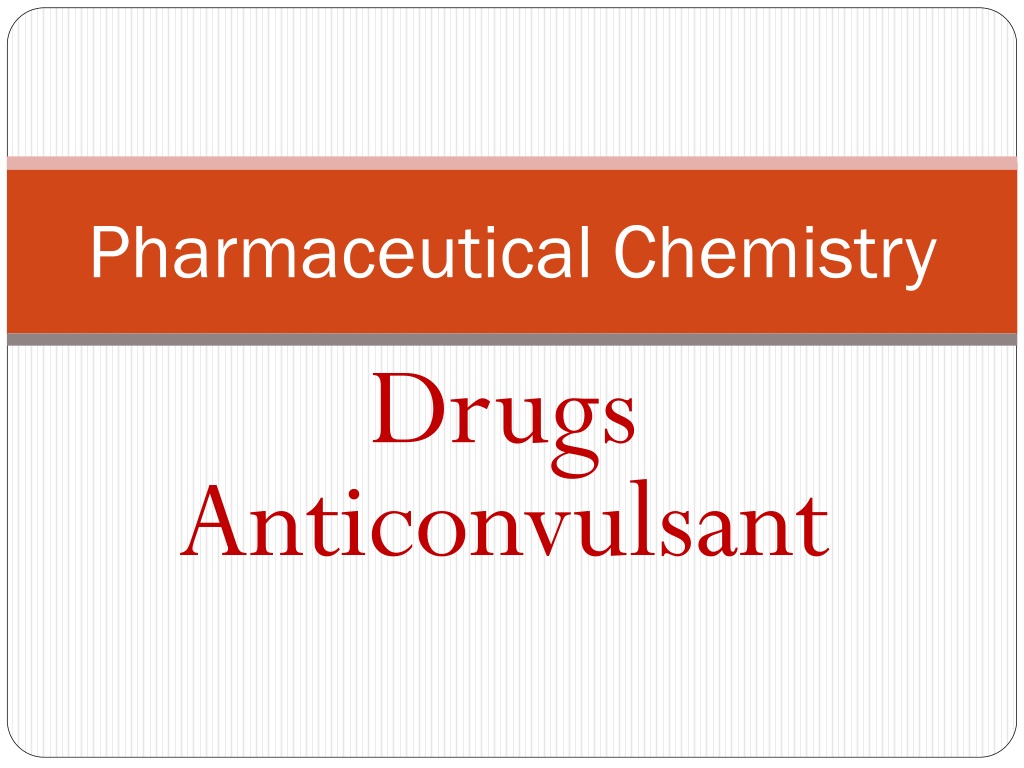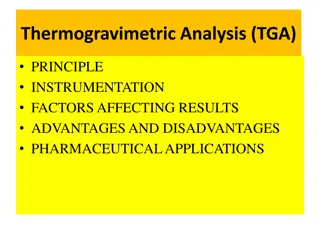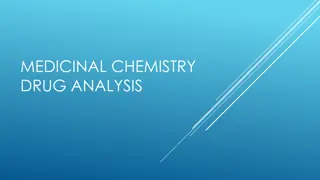Understanding Anticonvulsant Drugs in Pharmaceutical Chemistry
Anticonvulsant drugs play a crucial role in managing epilepsy, a common neurological disorder characterized by recurrent seizures. This article discusses the classification of epileptic seizures, mechanisms of action of anticonvulsants, and the role of GABA A receptors as targets for anticonvulsant therapy. Various types of anticonvulsant drugs and their actions on GABAergic inhibitory synapses are also explored.
Download Presentation

Please find below an Image/Link to download the presentation.
The content on the website is provided AS IS for your information and personal use only. It may not be sold, licensed, or shared on other websites without obtaining consent from the author. Download presentation by click this link. If you encounter any issues during the download, it is possible that the publisher has removed the file from their server.
E N D
Presentation Transcript
Pharmaceutical Chemistry Drugs Anticonvulsant
: Anticonvulsant Drugs ( Anticonvulsant Drugs (AEDs) AEDs) Epilepsy is not a disease. It is the most prevalent neurological disorder affecting more than 0.5% of the world s population. It is characterized by recurrent seizures. Seizures, on the other hand, are symptoms of disturbed electrical activity in the brain characterized by episodes of abnormal, excessive, and synchronous discharge of a group of neurons within the brain that cause involuntary movement, sensation, or thought. It is generally agreed that seizures may result from primary or acquired neurological disturbances of brain function as a result of an imbalance between excitatory and inhibitory processes in the brain. There are many possible causes of seizure including brain tumors or infections, head trauma, neurological diseases, systemic or metabolic disorders, alcohol abuse, drug overdose, or toxicities.
Classification of Epileptic Seizures and Recommended Initial Drug Therapy Seizures are classified, based on their initial signs and symptoms and the pattern seen on the electro-encephalogram (EEG), into two broad categories: Primary generalized seizures Two major types of generalized seizures are the primarily generalized tonic clonic seizures (grand mal) and the absence (petit mal) seizures. Partial seizures Major types of partial seizure are simple partial seizures (focal) and complex partial seizures (temporal lobe or psychomotor).
Mechanisms of action of anticonvulsants Mechanisms of action of anticonvulsants (A) Modulation of voltage-gated ion channels (Na, Ca2, and K). (B) Enhancement of - amino butyric acid (GABA)-mediated inhibitory neurotransmission. (C) Attenuation of excitatory (particularly glutamate-mediated) neurotransmission in the brain. Many of AEDs, especially the newer drugs, work by more than one of the above mechanisms of actions, therefore possessing a broader spectrum of antiepileptic action.
GABA A Receptors as Target for Anticonvulsant It is now well recognized that cellular excitability leading to convulsive seizures can be attenuated by GABA ergic stimulation in the brain. The GABAA receptor is one of two ligand-gated ion channels responsible for mediating the effects of GABA, the major inhibitory neurotransmitter in the brain. Activation of the GABAA / benzodiazepine (BZD) receptors /chloride channel complex allows increased chloride conductance, thereby preventing the spread of neuronal excitations.
The potential targets for AEDs action on the GABA ergic inhibitory synapses include: (a)Drugs that enhance the biosynthesis of GABA (gabapentin, pregabalin, and VPA) (b) Drugs that inhibit GABA degradation (vigabatrin). (c) Drugs that inhibit the reuptake of GABA (tiagabine) (d) Drugs that bind to an allosteric site on the postsynaptic GABAA receptor complex that increase chloride conductance (barbiturates, BZDs).
Phenobarbital and Primidone (Mysoline) Barbiturate anticonvulsants are a group of drugs derived from barbituric acid and they act by suppressing activity of the central nervous system. Barbiturate anticonvulsants enhance the action of GABA, which is an inhibitory neurotransmitter. Barbiturates channels and increases effectiveness of GABA. facilitate GABA-mediated opening of chloride
Barbiturates act as positive allosteric modulators and, at higher doses, as agonists of GABAA receptors. Barbiturates bind to the GABAA receptor and produce their pharmacological effects by increasing the duration of chloride ion channel opening at the GABAAreceptor. (This increases the efficacy benzodiazepines increase the frequency of the chloride ion channel opening at the GABAA receptor. (This increases the potency of GABA). of GABA), whereas
Primidone (Mysoline) Is metabolized phenylethylmalonamide (PEMA) Both of these metabolites have anticonvulsant activities. However, it is generally believed that the pharmacological action of primidone is mainly a result of the minor metabolite, phenobarbital. Thus, primidone is much less potent/toxic than phenobarbital, because most of the drug is rapidly degraded to the less potent metabolite, PEMA. by CPY2C9/19 to phenobarbital and
Voltage-Gated Ion Channels as Targets for Anticonvulsants Voltage-gated sodium channels (VGSCs) in the presynaptic nerve terminal of the excitatory glutamate receptors are the molecular target for phenytoin, Carbamazepine CBZ, and lamotrigine as well as some of the newer AEDs, such as Oxcarbazepine OXC, felbamate (FBM), and zonisamide. These aromatic AEDs inhibit excessive neuronal firing by binding to a site near the inactivation gate, thereby prolonging inactivation of VGSCs. The voltage-gated calcium channels (VGCCs) are essential in regulating Ca2 signaling, which is associated with many important cellular events such as the release of excitatory glutamate neurotransmitters, It has been suggested that excessive influx of Ca2 plays a critical role in the induction and progression of epileptic seizures
Voltage-gated potassium channels Potentiation of the voltage-gated K channels is another attractive target for designing of newer AEDs, associated with the membrane repolarization processes. Levetiracetam (LEV), a novel AED recently marketed for the adjunctive therapy of refractory partial seizures in adults, has been suggested to work by reducing the voltage-operated A-type potassium currents as one of its mechanism of actions
Hydantoins Hydantoins
Hydantoin Drugs Hydantoin Drugs
Carbamazepine (Tegretol) The two phenyls substituted on the urea nitrogen fit the pharmacophore pattern suggested for binding to the VGSC. Like phenytoin, CBZ is useful in generalized tonic clonic and partial seizures. Carbamazepine stabilizes the inactivated state of voltage-gated sodium channels, making fewer of these channels available to subsequently open. This leaves the affected cells less excitable until the drug dissociates. Carbamazepine is also a GABA receptor agonist, as it has also been shown to potentiate GABA receptors made up of alpha1, beta2, and gamma2 subunits Oxcarbazepine (Trileptal) (OXC) is a newer AED with a similar mechanism of action to CBZ except for its metabolic inactivation pathway.
Drugs that enhance the biosynthesis of GABA GABA, the major inhibitory neurotransmitter in the brain, is biosynthesized at the GABA decarboxylation of the amino acid, L-glutamic acid (itself an excitatory amino acid neurotransmitter in the brain). The essential cofactor for this enzymatic reaction is pyridoxal phosphate (vitamin B6). The rate-limiting enzyme that catalyzes this conversion is L- glutamic acid decarboxylase (GAD). 3-substituted GABA, gabapentin and especially pregabalin, may have the ability to activate GAD, Both of these drugs are weak activators of GAD. . ergic neurons by the
In addition to modulating calcium influx and stimulate GABA biosynthesis, they also compete for the biosynthesis of L-glutamic acid because of their structural similarity to L- leucine.
Valproic Acids pregabalin (VPA) also elevates brain levels of GABA in patients with epilepsy. (VPA), Similar to gabapentin and The exact mechanism of action of how this inhibition enhances GABA levels in the brain is still the subject of much debate (i.e., from an indirect stimulation of GAD to an inhibition of GABA-T). its use is limited by two rare but significant toxic side effects (hepatotoxicity and teratogenicity) that can be dose-dependent or idiosyncratic in nature. These drawbacks are apparently shared by its equipotent active metabolite, (E)-2-propyl-2-pentenoic acid (2-ene-VPA)
GABA, after its release from the synaptic nerve terminal, is degraded by another pyridoxal dependent enzyme, the GABA transaminase (GABA-T).
Drugs that inhibit GABA degradation Vigabatrin ( -vinyl-GABA) is an irreversible inhibitor of GABA-T, rationally designed based on the biochemical mechanism of transamination reaction. Briefly, vigabatrin, because of its structural similarity, competes with GABA for binding to GABA-T and forms a Schiff base intermediate with the cofactor, pyridoxal phosphate similar to GABA. However, unlike its substrate GABA, during the process of transferring the amino group to the pyridoxal phosphate, a reactive intermediate is formed with vigabatrin that immediately attaches itself to the active site of the enzyme, thereby irreversibly inhibiting GABA-T and increasing GABA levels in the brain. , It is marketed as an adjunctive treatment of patients with partial seizures.
Drugs that inhibit reuptake of GABA Tigabine: An uptake inhibitor. it blocks GABA reuptake as a major mode of its anticonvulsant activity. Its use is against partial seizures. Inhibitors of GABA transporter-1(GAT-1inhibitors) increase extracellular GABA concentration striatum, and cortex, thereby prolonging the inhibitory action of GABA released synaptically. in the hippocampus,
Ethosuximide (zarontin) and Methsuximide (celontin) Ethosuximide is considered the prototypical anticonvulsant needed for treating patients with absence seizures. Ethosuximide and the (N- dealkylated active metabolite) of methsuximide work by blocking the low threshold T-type calcium channels, thereby reducing the hyper excitability of thalamic neurons that is specifically associated with absence seizure.
Benzodiazepines (acts on a selective molecular target) Clonazepam: is useful in absence seizures and in myoclonic seizures. Diazepam: is given orally (Valium) or rectally (Diastat) as an adjunctive treatment in patients with generalized tonic clonic status epilepticus.
Novel Broad-Spectrum Anticonvulsants Lamotrigine, an AED of the phenyltriazine class, has been found effective against refractory partial seizures. Like phenytoin and CBZ, its main mechanism of action appears to be: Blockade of sodium channels. inhibits the high-threshold calcium channel, possibly through inhibition of presynaptic N-type calcium channels Blocks glutamate release.
Topiramate (topamax) TPM is a sulphamate-substituted monosaccharide, a derivative of the naturally occurring sugar D-fructose that exhibits broad and potent AED actions at both glutamate and GABA receptors. It has good oral bioavailability of 85% to 95%, most likely resulting from its structural similarity to D-glucose. Thus, it may be actively transported into the brain by the D-glucose transporter.
Zonisamide (zonegran, excegran) Zonisamide, a sulfonamide-type anticonvulsant was recently approved for adjunctive therapy in the treatment of partial seizures in adults with epilepsy. This biotransformation is mainly carried out by the intestinal bacteria. Again, because of the presence of a sulfonamide moiety in zonisamide molecule, precaution should be given to patients who have a history of hypersensitivity reactions toward sulfonamide drugs and concomitant use of zonisamide with other carbonic anhydrase inhibitors should also be avoided.
Levetiracetam (keppra) LEV is an analog of the nootropic agent, piracetam. Only the S-isomer has any anticonvulsant activity. Unlike piracetam, LEV does not have any affinity for the AMPA receptor ( -amino-3-hydroxy-5-methyl-4-isoxazolepropionic acid receptor) thereby has no nootropic activity for the treatment of Alzheimer disease. LEV also has no affinity for GABA receptors, BZD receptors, the various excitatory amino acid related receptors, or the voltage-gated ion channels. For this reason, its mechanism of anticonvulsant action remains unclear, but it appears to exert its antiepileptic action by modulating kainite/AMPA-induced excitatory synaptic currents, thus decreasing membrane conductance.






















